Bamberg and the Main - Day 6 our last full day
Today's theme is Bamberg and local German culture. This post continues the series describing our...
Today's theme is Franconia starting in Wurtzburg, Germany. This is the fifth post on our series about our trip aboard AmaWaterways Europe's Rivers and Castles river cruise. Previous posts can be found as follows: first post, second post , third post , fourth post .
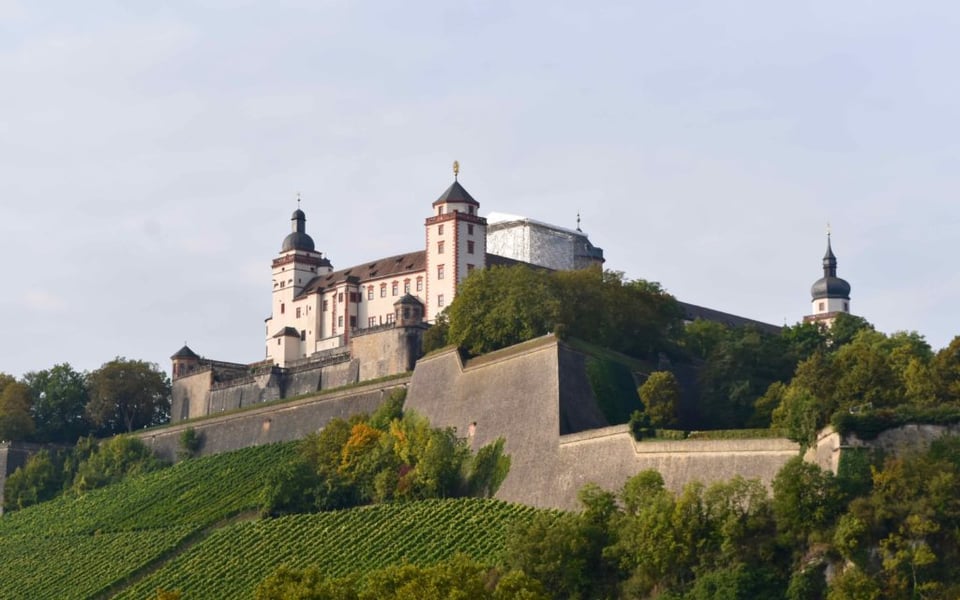 Marienburg Fortress in Wurtzburg
Marienburg Fortress in Wurtzburg
This morning we toured the city of Wurtzburg, Germany. We really didn't know anything about Wurtzburg but we were greeted with a grand city indeed. This is not a classic touristy city. Rather it's a working city with many great buildings and history. One of the most iconic is the Residenz palace. This is where the prince bishops lived. Being the leader of both the church and state created great wealth which can be seen not only in the palace but throughout the city. Others on our group toured the inside of the palace and reported it was truly magnificent, equal to Paris' Versailles Palace. We opted instead to tour the city which included a medieval Old Bridge which is older, though similar to, the St Charles stone bridge in Prague. The tour also included dom St. Kilian (yes, a cathedral in Germany named after an Irishman) as well as Wurtzburg's main streets. The Marienburg fortress overlooks the entire city offering picturesque views you can see above.
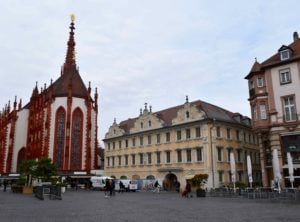 Central Wurzburg
Central Wurzburg
The city left me thinking this was a "real" German city, not something made up for tourists. We couldn't stay long but certainly we wouldn't mind coming back to more fully explore. After trying a pretzel on the street (not the best one we've even had) and a gluten free pastry (pretty good), we walked back to the ship along the Main River just in time for lunch.
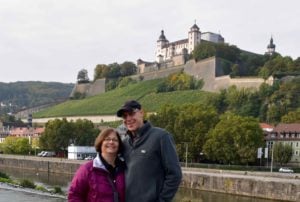 The author on the old bridge in Wurtzburg Franconia
The author on the old bridge in Wurtzburg Franconia
Lunch was a traditional German meal - sausage and sauerkraut, ham and pulled pork and of course beer (lager this time). Very nice as we are deep in the heart of Franconia. Wurtzburg is in the middle of the Franconia wine region. While technically a part of Bavaria, Franconians have a very different dialect as well as customs. The Bavarians drink beer, say good morning as Guten Morgen, wear lederhosen and buy cuckcoo clocks. Franconians drink wine, say good morning from god as Grub Gott, and eat sausages.
Franconians also pay an 8% tax that goes directly to the church. There were 40 some churches in this town of 120,000 most of which are Catholic. The locals made sure we knew the distinction between Bavaria and Franconia, both of which were historically separate kingdoms. Franconia is named after the Franks, the same as the country of France and there's surely some similarities in culture.
In the afternoon, we cruised up the river. There was an optional extra excursion to see Rothenburg during the afternoon - something to do on the next trip perhaps. And there was another option for a long bike ride. Instead we simply stayed aboard and took a bit of a nap, caught up with emails and finished some reading.
In the evening, we attended the Chaine De Rotisseurs dinner aboard the AmaDante. This is the chief's opportunity to impress as it celebrates AmaWaterways membership in this exclusive Gastronomic Society. A great meal consisting of cream of fennel and pernod aoup, lamb as well as many deserts and a selection of salads and cheeses. The lamb was among the best I've ever had - soft, tender and seasoned just right. The chief did impressed us all.
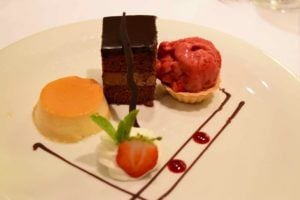 Desert at Chaine des Rotisseurs dinner
Desert at Chaine des Rotisseurs dinner
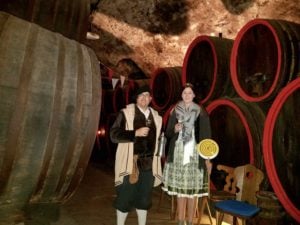 Kitzingen ambassadors in wine cellar
Kitzingen ambassadors in wine cellar
After dinner, we attended a wine tasting in Kitzingen at the Atter Kitzinger Klosterkeller. As early as 1482, Kitzingen established a wine law forbidding adulterated wine. Perhaps foreshadowing the German purity laws of 1516 - Reinheitsgebot - as they apply to beer. We were greeted on the ship by the local ambassadors who toured us through this very quaint town which is in the heart of the Franconian wine region. After a short walk we arrived at 700 year old wine cellars where we did our tasting. These same cellars were used in WW2 as bomb shelters.
Because this region is so far north, the local grapes are rather unique. The region only really
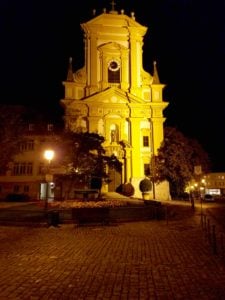 Kitzingen at night
Kitzingen at night
makes white wines and the ones in Kintzingen are quite dry overall and not your typical Reisling. We sampled a Tilmann Secco which is a nice sparkling wine ("Champagne's little brother" says the local wine guide). Next was the Franconian Bacchus which was very fruity, a Muller Thurgau which was a grape bred specifically for this region. The Franconian Silfaner was quite dry and the region's most famous variety that has been made since the 17th century. Finally we sampled a rose called Rotlin which was quite fruity.
Although it was late, it was a very nice after dinner activity. The little town is filled with historic buildings but clearly things get quiet at night. We were the only ones up and around on our walk back to the ship. The peace and quiet after the wine tasting was welcome.
During meals, you can order as much beer and wine as you wish. During dinner especially the waiters are constantly refilling your wine glass. You can sample white and red or just pick one for the duration of the meal. We've found the wines to be excellent table wines and especially appreciate that they rotate every day to reflect the local flavors. While I do notice some people ordering drinks from the bar before or after dinner, to my tastes the amount of beer or wine served with meals is sufficient that I don't need anything more. The servers will gladly fill up your glass as you leave as well. The AmaWaterways crew is very generous when it comes to drinks.
Franconians are proud of their traditions and food. Today we were able to sample a bit of both. Sometimes I tend to lump all Germans together, especially when thinking about the world wars. They are always depicted as the bad guys in our modern history books. But by visiting and site seeing, eating and drinking, talking and listening, the individual regions and personalities come through. Germany today is a far cry from the old Germany and the locals are very well aware of this. But they are not afraid of their history - either as Franks, citizens of the Holy Roman Empire, Prussians or Franconians within Bavaria. Theirs is pride of history but also of an economic miracle (as they say) because of the US Marshall plan involved in rebuilding the country after WW2. These people have strong traditions but also strong work ethic and pride which clearly has paid off. In Franconia, we are surrounded by vineyards as well as history and traditions. Not a bad place to spend some time.
Just like the grapes soak in the warmth from the sun when planted on south facing hills, we soak up new knowledge and experiences when cruising down the river.
Today's theme is Bamberg and local German culture. This post continues the series describing our...
Interested in a river cruise in Germany to see some great destinations? This is the fourth in our...